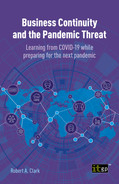PREFACE
As I am not a clinician or a virologist, I have been asked on a number of occasions how I got involved with pandemics and what inspired me to write not just one book on the subject but two. I honesty cannot remember when I first became aware of the word pandemic being used during a threat analysis exercise or appearing on a risk register. But it was more than a decade ago.
People may well remember the H5N1 bird flu outbreak in 2006 and the H1N1 swine flu outbreak in 2009. They may well also recall the panic that accompanied the Severe Acute Respiratory Syndrome (SARS) in 2002-2003, which was the first novel contagion of the new millennium. These events certainly helped to raise my own level of awareness.
Then in 2010, I was facilitating some risk management workshops for the Ministry of Health in the Republic of Malta. In case you are not familiar with Malta’s location, it is a group of five islands right in the middle of the Mediterranean Sea – about 100 kilometres to the south of Italy.
During the workshops, I noticed that when the subject of a pandemic was raised, people got very serious, and their body language suggested that we were talking about a threat that made them feel rather uncomfortable. When we had finished the exercise, the threat of a pandemic was not so much at the top of their list of priorities, but it was way out in front.
Before we all headed off in our respective directions, I took the opportunity to talk to the then Chief Medical Officer for Malta, Natasha Azzopardi Muscat, about pandemics. She left me in no doubt about just how dangerous they could be and why they needed to be at the top of a nation’s risk register. Natasha has since moved on and is now the Director of the Division of Country Health Policies and Systems at the World Health Organization (WHO).
In June 2015, I was invited to prepare and present a masterclass, first in Hong Kong and then again in Dubai. The subject was to be business continuity and pandemics. Having accepted the invitation, I duly started to design the delivery structure, when it occurred to me that there would be more than enough material to actually write a book on the subject and Business Continuity and the Pandemic Threat was published in 2016. Needless to say, I was delighted that the publication became a bestseller.
So why only five years later am I now writing a companion book? The simple answer is COVID-19. Instead of predicting what could happen during a serious pandemic, we are now living through one.
I am no stranger to business continuity, having received peer recognition over my many years of involvement in the discipline, which stands alongside my corresponding academic qualifications. This book is also my fifth business continuity related publication. Moreover, the pandemic threat is primarily (although not exclusively) about people and how to manage your business with a substantially depleted workforce. Human resources (HR) management departments will need to take a leading role in dealing with the pandemic issues that affect their employees. Here I have been able to draw upon the experience I gained during the five years I spent as the resourcing director for Fujitsu Consulting for Northern Europe. During this time, I had responsibility for managing approximately 1,500 consultants across five countries.
Like its prequel, writing this book has naturally necessitated undertaking a great deal of research, although this has been while we were in the middle of a pandemic rather than before or after the event. This time, the focus has been specifically on the virus SARS-CoV-2 and its associated disease COVID-19. I can tell you that as my research progressed, my appreciation of the enormity of the pandemic threat has increased beyond measure. So too has my genuine concern about the conceivable damage that is being inflicted on life as we know it – both professionally and personally.
In writing this book, in general I have used the United Kingdom (UK) as the benchmark for pandemic preparedness. I also make several references to the UK National Risk Register (NRR), which is in the public domain. I do naturally accept that other countries around the world may be more or less well prepared than the UK. That said, the pandemic threat is taken very seriously in this country, and is considered to be a Tier 1 threat to its security and economy, ranking alongside terrorism, war, cyber threats and natural disasters.
Since this book considers the pandemic threat primarily from a business continuity context, it is certainly not full of jargon that an infectious diseases clinician or virologist would thrive upon. Instead, while it has been necessary to make appropriate references to various bacterium and viruses, it also looks at what history has taught us and how we can apply those lessons to better protect our businesses, and ourselves, from what is an inevitability – the next pandemic.
